| home previous page |
NORLEX |  |
| home previous page |
NORLEX |  |
The sandstones are considered to have deposited by mass flow processes into a deep marine palaeoenvironment from the north or north-west during a renewed period of basin margin uplift and rifting and within the period of the rift climax stage of Færseth and Lien (2002).
Derivatio nominis: The name Hvithval is the Norwegian name for the white whale or Beluga species Delphinapterus leucas. The species is a toothed whale species of moderately large size (reaching up to 4.5m long) that are found in small schools or flocks in cold Arctic seas such as the Polar Sea around Svalbard and the Barents Sea.
The sandstones are white - yellow light grey, medium grey - medium dark grey to light brown grey, clear quartz grains, transparent to translucent, colourless, white to pink, very hard, loose, very fine to coarse, predominantly fine to medium, occasionally very coarse, angular to rounded, generally sub-angular to sub-rounded, poorly to moderately sorted, well cemented, siliceous cement with occasional calcite cement, argillaceous, silty, occasionally pyritic, glauconitic, chloritic, micaceous, trace of carbonaceous material, with no or poor visible porosity, occasionally grading to siltstone.
The subordinate mudstones are light - medium grey to brown grey, predominantly firm, occasionally soft to moderately hard, amorphous to blocky or sub-fissile, with disseminated and nodular pyrite, glauconitic, micaceous, silty, sandy, occasionally very sandy, and moderately calcareous with occasional dark laminae.
The siltstones (developed particularly in the lower part of the member), are light to medium grey, soft to firm, friable, argillaceous matrix, disseminated pyrite, arenaceous with very fine to fine sand, micaceous, glauconitic, non to moderately calcareous.
The infrequent limestone stringers are white- very light grey to medium dark grey- brown grey, firm, microcrystalline, silty, occasionally sandy with traces of glauconite and micro- mica.
The dolomite stringers are white to very light grey, firm to moderately hard and blocky.
Reference well 6707/10-1: 4 slides from ditch cuttings covering the interval 2230m - 2410m deposited at the NPD (DONG preparations).
This represents the uppermost part of the member and includes the unconformable upper boundary with the overlying Rogaland Group. The boundary is not readily identifiable in spite of being an unconformity. The boundary is a sand/sand contact and in addition to the marked difference in age, the overlying basal Tang Formation is characterised by glauconitic sandstones seen at the top of core #1 between 2554m and 2555.1 m (uncorrected measured depth). The core shift is -2.3m.
Reference well 6707/10-1: no core was taken in this member.
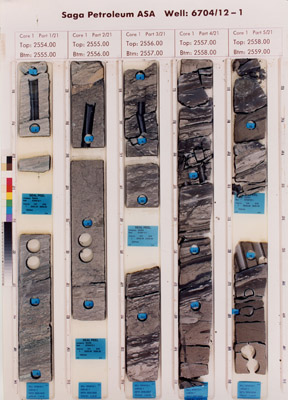 6704/12-1, 2554-2559 m |
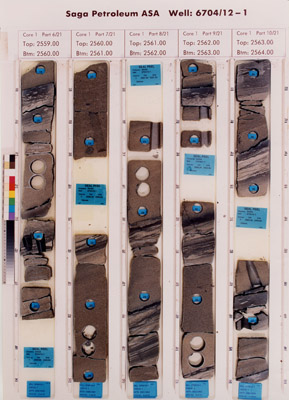 6704/12-1, 2559-2564 m |
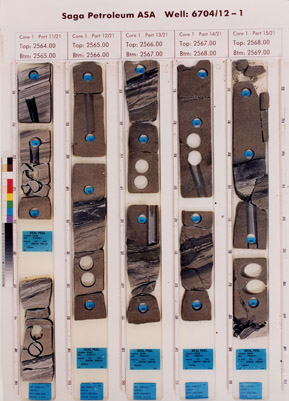 6704/12-1, 2564-2569 m |
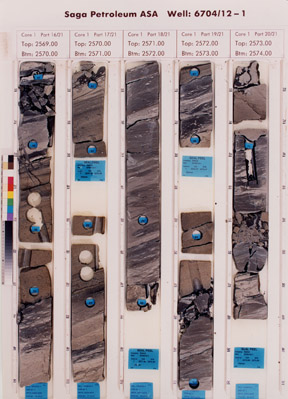 6704/12-1, 2569-2574 m |
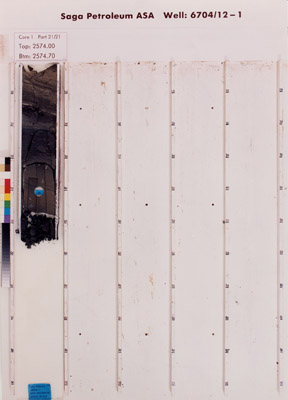 6704/12-1, 2574-2575 m |
 6704/12-1, 2997-3002 m |
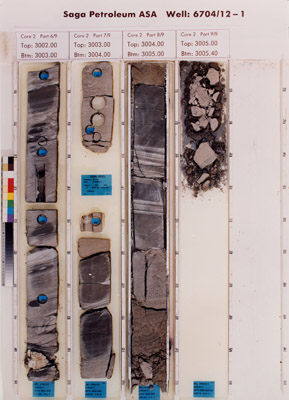 6704/12-1, 3002-3005 m |
Occurrences of formation tops in wells
In the basal part of the member in the Gjallar Ridge type well 6704/12-1, the LCO Odontochitina operculata, LO O. costata, O. 'wetzelii' Wilson 1974 suggests an age at least as old as early Maastrichtian (Zone 23) and the associated occurrence of the dinocyst marker Palaeohystrichophora infusorioides is typical of the late Campanian (Zone 24). The LAO Heterosphaeridium heteracanthum in the underlying mudstones of the Nise Formation confirms a late Campanian age. In the Nyk High reference well 6707/10-1 the base of the Hvithval Member is slightly younger being above the Odontochitina plexus.
The youngest extent of the member in the type well 6704/12-1 is early Maastrichtian and developed below the LO Alterbidinium acutulum. In the reference well 6707/10-1, the upper part of the member is within the acme of Impagidium 'septentrionalis' indicating a slightly younger intra-late Maastrictian age.
In general, the microfaunas are dominated by typical Cretaceous agglutinated foraminifera, notably LO Caudammina ovula; LO Rzehakina epigona, LO Kalamopsis gryzybowskii and the planktonic foraminferal species LO Heterohelix globulosa.
In the type well 6704/12-1 the upper boundary of the Hvithval Member is unconformable and coincides with base of glauconite rich sandstones of the Tang Formation in core at 2555.1mMD (2552.7m corrected core depth). A stratigraphic break in the order of 10 m.y. is indicated. The overlying interval yields the Middle Paleocene dinocyst markers LO Isabelidinium viborgense, LO Palaeocystodinium bulliforme and LCO Palaeoperidinium pyrophorum.
The sandstones were deposited within a large scale, deep-water, distal basin floor fan (Fugelli and Olsen, 2005b) as part of their play 1 concept. The sandstones were presumably deposited by mass flow processes with sediments originating from the north or north-westerly locations towards the Greenland mainland.
In their study of outcrop analogues, Fugelli and Olsen (2005a), considered the sand-rich fan complex of the Brushy Canyon Formation in the Delaware Basin, USA to be an analogous system.
In the background mudstones of the member, the presence of agglutinated microfaunas (DWAF) suggest a relatively deep, upper to middle bathyal water depths with oxygen poor bottom conditions.
Fugelli, E. and Olsen T. R. 2005b. Risk assessment and play fairway analysis in frontier basins: Part 2 - Examples from offshore mid- Norway. AAPG Bulletin, 89(7), 883-896.
Færseth, R. and Lien, T. 2002. Cretaceous evolution in the Norwegian Sea - a period characterized by tectonic quiescence. Marine and Petroleum Geology, 19, 1005 -1027.
Lien, T. 2005. From Rifting to drifting: effects on the development of deep-water hydrocarbon reservoirs in a passive margin setting, Norwegian Sea. Norwegian Journal of Geology, 85 319-332.
Vergara, L., Wreglesworth, I., Trayfoot, M., Richardsen, G. 2001. The distribution of
Cretaceous and Paleocene deep-water reservoirs in the Norwegian Sea basins. Petroleum
Geoscience, 7, 395-408.
| home | previous page |